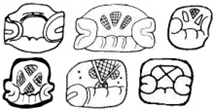![]()

![]()
TOK.p29.r5.c2 = BMM9.p18.r7.c2 K&L.p18.#3 [25EMC.pdfp41.#7.1 = K&L.p18.#3.4] 25EMC.pdfp41.#7.2
MAK MAK MAK MAK
· No glyphs given in K&H.
· Do not confuse this with the visually similar AHK = “turtle” (see Zender-TtTfiS):
o AHK has waterlily markings on the shell.
o MAHK has 3 or 4 wedges in a circle or semicircle (reminiscent of pie or pizza slices), usually cross-hatched.
The risk of confusion is particularly great if the AHK has an infixed K’AN, e.g. in the name Itzam K’an Ahk:
o [K’AN]AHK has a “vertical-and-horizontal” cross – the bands run E-W and N-S.
o MAHK has a “diagonal” cross (the wedges – if there are four of them – result in bands running NW-to-SE and SW-to-NE.
· Meaning:
o K&L.p18.#3: ‘turtle carapace’ also ‘get engaged, be betrothed’’ (supported by PNG Stela 1 J2).
o Bíró-ONtM (implicitly) warns against assigning modern English translations for two other verbs ma(h)k = “to cover” – found in the passive as mahkaj – and naw = “to present” – found in the passive as nahwaj – on (among others) PNG Stela 1, 3, and 8. Bíró-ONtM.p2.fn2: The translations of the transitive verbal roots mak- and na- went through several phases and their interpretations in Piedras Negras texts have a long history. The most recent treatment of the verb mak- is by Kerry Hull and Michael David Carrasco (2004) who argued that its general meaning was to cover over a certain space and list various rituals which all used this particular verb. Mak- is a reflect of proto-Mayan *maq- and all of its cognates have the general meaning of “to cover, to close” (Kaufman 2003:866-867). It frequently occurs in parallel constructions with the verb pas- which is the Classic Period form of the transitive verb *päs~“to show, uproot, uncover” (Kaufman and Norman 1984:128). Marc Zender (2005:5-6) also detailed the derivations of the root mak- and he explicitly translates the Piedras Negras mahkaj as “she is enclosed”.
· Pronunciation:
o K&L gives the pronunciation as mahk (with aspirated vowel) – it is transliterated as MAK as they never transliterate “disharmonic” vowel qualities anyway.
o BMM9 gives the pronunciation as mak – inherited from EB.
o Zender-TtTfiS allows for either mak or mahk, with a personal preference for mahk.
o On PNG Stela 1, it would be mahk- anyway, irrespective of whether the root verb is pronounced mak or mahk, because the -h- would be inserted for the passive.
![]()
![]()
![]()
![]()
JM.p167.#2 JM.p167.#3 Stuart = Montgomery
PNG Stela 1 J2
ma.ka <ma:ka>.ja <ma:ka>.ja